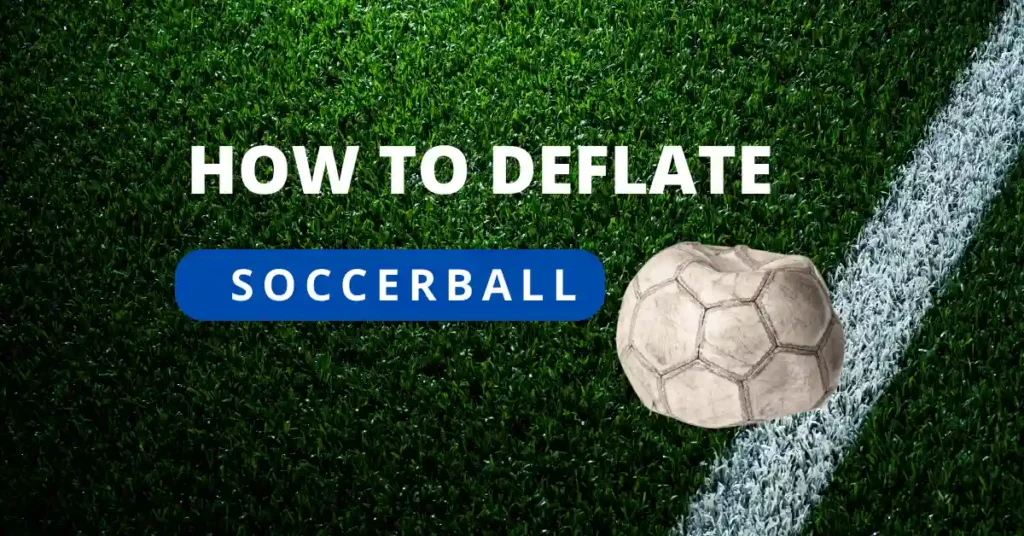Deflating a soccer ball is a common practice for players and coaches, as it allows them to adjust the ball’s air pressure to suit their preferences and the conditions of the game. However, it is important to know how to deflate a soccer ball properly to avoid damaging it or affecting its performance. In this article, we will cover several different methods for deflating including using a ball pump, a pen, a paperclip, and other household objects.
Deflating A Soccer Ball 2023

A deflated soccer ball is a ball that has had some or all of the air released from it. It is also sometimes necessary to deflate a ball before patching it or repairing it. Firstly, a ball that is not properly deflated can be difficult to handle and may not perform as intended. A ball that is too soft may be difficult to control, while a ball that is too hard may be uncomfortable to play with. Additionally, overinflated balls can be prone to bursting or tearing, which can be dangerous and result in injury.
6 Steps To Deflate A Soccer Ball With A Pen:
One method for deflating a soccer ball is to use a pen. To do this, follow these steps:

1. Locate the ball’s valve: The valve is a small, circular opening on the ball where the air is either pumped in or released. It is usually located on one of the panels of the ball and is covered by a rubber or plastic cap.
2. Remove the valve cap: Use your fingernail or a small, flat object (such as a coin or a screwdriver) to gently pry the valve cap off the ball. Be careful not to lose the cap, as it helps keep the valve clean and prevents dirt and debris from entering the ball.
3. Insert the pen into the valve: Carefully insert the pen into the valve, with the tip facing towards the inside of the ball. The pen should fit snugly into the valve, with just a small amount of resistance.
4. Deflate the ball: Slowly and steadily push down on the pen to release the air from the ball. You can stop at any time to check the ball’s pressure by pressing the ball with your thumb and feeling the resistance. The ball should feel strong but not too hard. If it feels too soft, you may need to add more air. If it feels too hard, you may need to release more air.
5. Remove the pen from the valve: Once you have deflated the ball to your desired level of pressure, remove the pen from the valve. Be sure to hold the ball and the pen firmly to prevent the ball from bouncing away.
6. Replace the valve cap: To prevent dirt and debris from entering the ball, replace the valve cap on the ball. Make sure the cap is securely tightened, as a loose cap can cause air to escape and affect the ball’s performance.
It is important to note that using a pen to deflate a soccer ball can be more time-consuming and less precise than using a ball pump. Additionally, using a pen can potentially damage the ball if the pen is inserted too far or if it is not inserted evenly. Therefore, it is generally recommended to use a ball pump whenever possible.
7 Ways To Deflate A Soccer Ball With A Paperclip:
Another method is to use a paperclip. To do this, follow these steps:
1. Locate the ball’s valve: The valve is a small, circular opening on the ball where the air is either pumped in or released. It is usually located on one of the panels of the ball and is covered by a rubber or plastic cap.
2. Remove the valve cap: Use your fingernail or a small, flat object (such as a coin or a screwdriver) to gently pry the valve cap off the ball. Be careful not to lose the cap, as it helps keep the valve clean and prevents dirt and debris from entering the ball.
3. Straighten out the paperclip: Take a paperclip and straighten it out so that it is a long, thin wire.
4. Insert the paperclip into the valve: Carefully insert the paperclip into the valve, with the tip facing towards the inside of the ball. The paperclip should fit snugly into the valve, with just a small amount of resistance.
5. Deflate the ball: Slowly and steadily push down on the paperclip to release the air from the ball. You can stop at any time to check the ball’s pressure by pressing the ball with your thumb and feeling the resistance. The ball should feel strong but not too hard. If it feels too soft, you may need to add more air. If it feels too hard, you may need to release more air.
6. Remove the paperclip from the valve: Once you have deflated the ball to your desired level of pressure, remove the paperclip from the valve. Be sure to hold onto the ball and the paperclip firmly to prevent the ball from bouncing away.
7. Replace the valve cap: To prevent dirt and debris from entering the ball, replace the valve cap on the ball. Make sure the cap is securely tightened, as a loose cap can cause air to escape and affect the ball’s performance.
It is important to note that using a paperclip to deflate a soccer ball can be more time-consuming and less precise than using a ball pump. Additionally, using a paperclip can potentially damage the ball if the paperclip is inserted too far or if it is not inserted evenly. Therefore, it is generally recommended to use a ball pump whenever possible.
How Do You Deflate A Soccer Ball Without A Pump?
It is not a good idea to deflate a soccer ball without a pump and an inflation needle. Your ball can wind up being permanently damaged. However, if you need to deflate a game of soccer, ball, and you cannot find a pump or needle; here is how you can do it.
You will need a paper clip or any other thin, blunt-free object that can fit inside the ball’s valve. You might require an additional pair of hands to help you deflate a soccer ball using this method. To insert the paper clip or other object into the bladder without shattering it, you will need steady hands.
Tips For Maintaining A Deflated Soccer Ball
• Store the ball properly: Proper storage is important for maintaining a deflated soccer ball. It is best to store the ball in a cool, dry place away from direct sunlight. Avoid storing the ball in damp or humid environments, as this can cause the ball to become mouldy or damaged.
• Use the ball within the recommended pressure range: Each soccer ball has a recommended range of inflation pressure, which is the amount of air pressure needed to properly inflate the ball. It is important to use the ball within this range to ensure optimal performance and minimize the risk of injury. For example, a ball with a recommended range of 8.5-15.6 PSI (pounds per square inch
Does Deflating A Soccer Ball Damage It?

Deflating a soccer ball on its own will not damage the ball, as long as it is done properly. However, if the ball is deflated too much or too quickly, it can cause the ball to become misshapen or cause the seams to come apart. Additionally, if the ball is deflated with a sharp object or by applying too much force, it can puncture the ball and cause it to become unusable.
Any of the above-mentioned techniques will flatten your soccer ball for storage. Use the pump and needle approach instead of the paper clip method whenever you can to extend the lifespan of your ball and prevent potential harm. You can keep your soccer ball in peak condition wherever you travel if you know how to deflate a soccer ball.
Frequently Asked Questions – FAQ
How To Deflate A Football?
The association football ball can also be deflated with the use of this needle. To smooth the needle and prevent the valves from deteriorating, moisture is applied. The air escapes from the ball once it is put into the valve. The pump needle is progressively drawn out of the ball if the necessary amount of air is reached.
What Should I Do If The Air Ball Is Deflating?
Try not to press too hard because doing so can harm your bladder. Ask your companion to squeeze the ball gently and gradually until all the air has been released and the ball is flat. Make sure to maintain your upright position while gripping the needle as the ball deflates. Save the ball and the pump after removing the needle.

Sophia Jackson is an expert writer and avid soccer enthusiast. With a passion for the game and a wealth of knowledge about soccer balls, she’s dedicated herself to providing comprehensive guides and useful information for soccer players of all ages and skill levels

